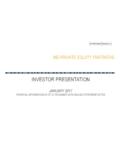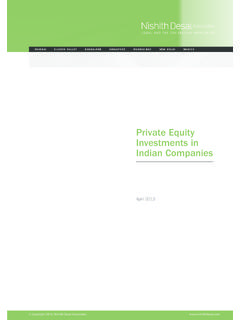Transcription of An Overview of the Private Equity Distressed Debt and ...
1 Distressed debt and restructuring investing is a small butgrowing sector of the Private Equity market, one with severalunique characteristics: In a Private Equity market that is becoming increasinglyglobal, it is one where local laws and regulations still have asignificant impact. For many investment strategies,local bankruptcy laws and their practical application aretremendously important though for global companies thequestionof whichbankruptcy law applies is not alwaysstraightforward. Hedge funds are a significant competitor in the ,hedge funds have begun to compete with privateequity funds for transactions on a limited basis. In theDistressed Debt sector, however, hedge funds have beensignificant competitors for years, especially for funds pursu-ing Distressed Debt Trading strategies.
2 Within the sector, fund managers pursue greatly divergentinvestment strategies. The investment strategies used byfund managers in the sector (described in further detail inthe Investment Strategy sector below) are very differentand require diverse skill sets to execute successfully. Investment opportunities in the sector are counter-cyclicaltothe general Private Equity sectorssuch as buyouts, venture capital, and mezzanine investmentare not totally dependent upon general economic cycles, buttheir returns are generally positively correlated to econom-ic trends; a strong economy in general helps generate strongreturns and a weak economy hurts returns. The reverse istrue of Distressed Debt and Restructuring Funds, as a weakeconomy generates in general increased investment factors make the sector complex, and this chapter ismeant to provide a general Overview of issues that are coveredin depth in a number of the other STRATEGIES AND DEFINITIONSB efore covering how the market has developed, it would beuseful to define the investment strategies that are prevalent inthe market.
3 It needs to be said that the pure strategiesdescribed beloware useful for discussion purposes, but thatmany funds utilize hybrid strategies in some form of Debt TradingAt its simplest, Distressed Debt Trading involves purchasingdebt obligations trading at a Distressed level for example at40% of par value in anticipation of reselling those securitiesover a relatively short period of time at a higher level, gener-ating a trading profit. Distressed Debt traders are looking forinvestment opportunities in which they believe the debt obli-gations are fundamentally mispriced and will rebound holding period on an individual security is usual-ly weeks, sometimes days, and the size of a particular positionis not directly is the most liquid of these invest-ment strategies,and in part for that reason hedge funds aremajor players in this Debt: Active/Non-ControlActive/Non-Control strategies are substantially differentfrom Trading strategies in that their goal is to accumulatesignificant positions in companies that are likely to gothrough, or are in, a bankruptcy restructuring process.
4 The17An Overview of the Private Equity Distressed Debt and Restructuring MarketsKelly DePonte, Partner, Probitas Partners goal is to gain a position of influence in that restructuringprocess in which the value of securities and indeed thenature of the end securities exchanged is negotiated inbankruptcy in order to maximize returns. This complexprocess necessitates a longer holding period than in Trading,as well as larger, more concentrated portfolio Debt: ControlIn this strategy, the fund manager builds a controlling positionin the fulcrum Distressed security in a bankruptcy proceedingin order to effectively buy control of the target companythrough the bankruptcy process, either alone or as part of asyndicate.
5 With this strategy, the Distressed debt position is inmany respects the start of a much longer process, as after thefund manager wins control of the target he acts very much asa buyout fund manager would, controlling the company andturning it around in order to maximize or TurnaroundRestructuring or Turnaround funds target companies in dis-tress but buy them utilizing Equity ,sometimes purchasingthem before an expected bankruptcy and other times in thebankruptcy process. Their goal much as it is for DistressedDebt:Control funds is to get control of companies in dis-tress cheaply and then restructure them. This strategy alsorequires detailed knowledge of local bankruptcy law in a sim-ilar manner to the Distressed debt funds follow any one of these strategies in a pure example, both Distressed Debt: Active/Non-Controland Distressed Debt.
6 Control managers use smaller tradingpositions for reconnaissance purposes,sometimes buildingthem up further into core positions and at other times liqui-dating the position in order to move on to another restructuring funds that normally do not deal in dis-tressed debt have occasionally taken control positionsthrough debt instead of addition, a number of regular buyout funds will on occa-sion do turnaround transactions, at times in a syndicate witha Restructuring focused fund or at other times taking thelead themselves. This most often occurs when they have par-ticular industry or country expertise (as was the case withRipplewood and Flowers in the Shinsei Bank transac-tion in Japan) though in general buyout funds avoid restruc-turing transactions especially if the company is already , though not Private Equity funds per se, there are alsoopportunistic real estate funds that are focused on distressedtransactions, and several firms such as Cerberus and LoneStar got their start in this area before broadening their man-dates into corporate investments as well.
7 The dynamics of thedistressed real estate market are somewhat similar to the pri-vate Equity market,though the economic cycles and the typesof assets are quite ROLE OF BANKRUPTCY LAWIn most Distressed Debt and Restructuring funds, deepknowledge and experience in bankruptcy law and its process-es are key to success. Though it can be argued that DistressedDebt Trading strategies may be driven more by market psy-chology and trading dynamics, in all the other strategiesknowledge of the law and its practical workings is key is the fact that - as is discussed in other chapters ofthis book - the details of bankruptcy regulation can differtremendously country by country. Success in one legal envi-ronment under a specific set of regulations does not set atemplate that can be automatically duplicated in starting point for any discussion of legal ramifications inDistressed Debt and Restructuring strategies is Chapter 11of the bankruptcy code, adopted in 1978.
8 This provisionof the code for the first time put real stress on reorganizing acompany so it could continue to operate instead of focusingon liquidating a company. The intention of the law was toboth ease impacts on stakeholders like company employeesand suppliers by having a revitalized if restructured company18 The Guide to Distressed Debt & Turnaround Investingstill in operation, and to provide debtors with at least thepotential for a higher level of recuperation on defaulted secu-rities than would be possible in a real reorganization mechanisms in place, it began to bepractical to try to take control of companies through thebankruptcy process. Liquidity preference (see the attachedtable) became not just relevant in the liquidation of a compa-ny but crucial in control of a restructuring.
9 The fulcrumsecurity in a restructuring would be the instrument likely tocontrol the future of the company with the size of overallpotential losses determining which investment securitieswould be wiped out and which might be converted into com-mon Equity controlling the reorganized 1 SIMPLIFIED PREFERENCE STRUCTURE Secured DebtSenior DebtSubordinated DebtPreferred StockCommon StockFor a number of years the stood alone with this approachto bankruptcy, but as these changes took hold other countriesbegan to consider and then adopt this approach. However,the market is still the most advanced in this area, espe-cially as regards tried and true processes and methods ofapplying the regulation. In addition, though a number ofcountries have adopted the general approach of allowing therestructuring of companies instead of forcing liquidation,specific law in each jurisdiction is different, for example, evenwithin the European BEGINNINGS OF A MARKET.
10 SUPPLY AS WELL AS STRUCTURET hough a bankruptcy law favorable to restructuring asopposed to liquidation was a necessary first step in the creationof the Distressed Debt and Restructuring Market, the otherkey item necessary was a supply of transactions that wereattractive and presented a critical mass of opportunities neces-sary to get investors to devote time and attention to the the 1980s, the supply of Distressed Debt was providedby Fallen Angels debt instruments that had originallybeen issued by investment grade obligors whose credit stand-ing and repayment ability had fallen. Though there was aconstant supply of this type of paper as individual companiesgot into financial trouble in all sorts of economic environ-ments, the supply was actually rather low and a number ofthese Fallen Angels were so badly troubled that liquidationwas still preferable to 1980s, however, saw the creation of a new type of debtmarket the high yield new issuance or junk bond market in which highly levered companies issued non-investmentgrade paper with high coupon levels reflecting the increasedfinancial risk inherent in their capital structures.









